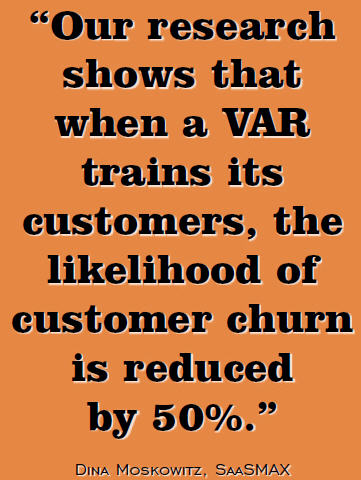What Every VAR Needs To Know About Data Management
By Jay McCall, networking and managed services editor, Business Solutions magazine
Your customers’ data is one of their greatest assets. If you’re just protecting it, you could be limiting your role in helping customers thrive.

According to a recent research report from IDC, digital information created, captured, and replicated worldwide grew tenfold over a five-year period between 2006 and 2011. Further compounding this issue for your customers is the BYOD (bring your own device) trend where employees are increasingly intermingling their personal data (e.g. pictures, videos, articles) with their work data, which further burdens end users with data management responsibilities.
Where there are business challenges, however, there is a need for competent IT solutions providers to help. To get to the bottom of the important data management trends that demand VARs’ attention, I spoke with industry experts from CA Technologies, Datto, SaaSMAX, and Symantec. The following is their advice regarding the best opportunities in data management as well as some of the pitfalls you’ll need to avoid.
Identify Your Customer’s Primary Data Management Concern
Getting a handle on your customer’s sprawling structured and unstructured data can be a daunting task for them as well as for you. A good place to start is to consider the most important reason for them to solve this issue. Following are three common drivers:
Compliance — For customers in regulated industries such as healthcare or finance, being compliant is a top priority. For example, the HITECH Act, which went into effect February 2009, started the clock ticking for healthcare providers to make the transition to EHRs (electronic health records) by 2014. According to research from IT industry association CompTIA, only 41% of small medical providers will be compliant with digital records by this deadline. A VAR could make a good living by gaining expertise in EHR offerings and helping healthcare providers make the transition from paper files to digital.
Downtime — Even though all your customers will give lip service to the value of keeping their networks up and running, many don’t realize just how dire downtime is. In fact, according to a 2011 survey sponsored by CA Technologies, North American businesses lose $26.5 billion annually from avoidable downtime. A major reason for this expense is that 66% of companies surveyed had no disaster recovery strategy in place. “A lot of companies don’t realize the cost of loss of reputation and loss of employee productivity that goes along with network downtime,” says Steve Fairbanks, vice president of data management at CA Technologies. “VARs can provide value to their customers by helping them develop a recovery point objective [RPO], which is the maximum tolerable period in which data might be lost during a network or Internet outage.” Once the RPO is established, both parties can establish what level of business continuity is necessary. Fairbanks advises VARs presenting backup options as good, better, and best. “A local backup combined with data replicated to the public or private cloud is good, but creating a full backup to the cloud along with a virtualization environment is even better,” he says. “The best scenario, for customers in verticals such as finance that can tolerate only a few minutes of downtime, is to offer continuous replication to the cloud along with virtualization, so that data could be restored instantly in the event of a local server failure.” Customers also need to understand the cost of a business continuity solution will increase from about 50 cents per gigabyte for a “good” solution to more than a dollar per gigabyte for the “best” solution.

Cost — Some of your customers may not be governed by industry regulations, and maybe being down for a few hours isn’t a major threat to their existence either. In this case, you can still play an important role by evaluating their existing data infrastructure and showing them ways to reduce their data management costs. “A recent Symantec survey found that organizations average seven different tools for backup across both physical and virtual environments,” says Kelly Smith, senior manager of product management at Symantec. “And, only 28% of the survey respondents felt completely confident that 100% of their backed up data could be recovered.” Using disparate backup systems, combined with sprawling storage silos, adds a lot of unnecessary cost and complexity for end users.
One solution to this problem is creating a virtualization environment for your customers. According to David Lasecki, technical support engineer at Datto, “Performing a physicalto- virtual [P2V] server migration is usually the easiest type of server migration and offers the benefits of lowering power consumption, plus it enables VARs to more easily change resources on the server on an as needed basis. With the ability to share open source file formats, a VAR can copy files to the virtual machine host and instantly create a virtual machine that boots from these files.” Some end users have reported as much as a 70% reduction in data center power costs by switching to a virtualization environment, not to mention the cost savings of prolonging their storage investments.

Avoid Three Common Data Management Pitfalls
With any IT solution, VARs need to beware of some common pitfalls. Industry experts recommend paying close attention to these three areas:
Control Data Growth: “Data deduplication is the key to avoiding this pitfall,” says Smith. “When VARs deduplicate at the source, they dramatically improve their customers’ system performance and lower the cost of protecting information.”
Unify Platforms: “Point solutions only add complexity and additional management costs,” says Smith. “By unifying platforms, partners can put an end to customers’ duplicated work by the backup and virtual machine teams, reducing complexity and costs.”
Training: “With cloud-based apps, there are features and functionality that can be overlooked or underutilized without the appropriate training and education,” says Dina Moskowitz, CEO of SaaSMAX. “If this happens, the end user may place a lower value on the solution and, subsequently, on the VAR.” In some instances, a customer may incur unnecessary expenses by looking for additional solutions which are already addressed by a VAR’s existing solution. “Our research shows that when a VAR trains its customers, the likelihood of customer churn is reduced by 50%.”
